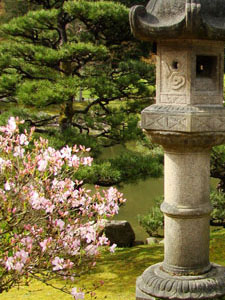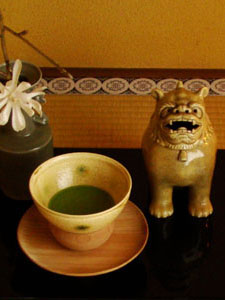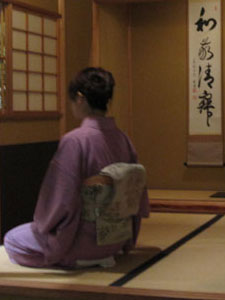Introduction to Japanese Tea Ceremonies



Seattle is fortunate to call itself home to two traditionally constructed Japanese tea houses. The tea houses are accessible to the public, but are nestled into spaces where the urban explorer is unlikely to stumble upon them by chance. Both of these marvelous structures are under the oversight of the Seattle Branch of the Urasenke Foundation, the most well-known school of Chanoyu, the Japanese way of tea. In addition to using the tea houses in the course of their own study and practice, the Urasenke Foundation also offers opportunities for the public to observe demonstrations of Chado, the highly formalized Japanese matcha (powdered tea) ceremony.
The larger of the two locations is the six-tatami mat tea house named Shoseian ("Arbor of the Murmuring Pines"), located on a low hill in the Seattle Japanese Garden, inside of the Washington Park Arboretum, which will be celebrating the fiftieth anniversary of its opening this June. In the end of March I attended the very special yearly Founder's Day celebration, honoring Sen no Rikyu, the sixteenth century tea master who solidified the way of tea maintained and practiced currently by the Urasenke School. The ceremony itself was extraordinary, inaugurated with a very lovely arrangement of a single red camellia (notably a cousin to the tea plant) and implemented with the most prized of the school's tea wares, including one exquisite tea bowl by Okada Yutaka and another by Okada Kakei, and an unusually robust tea scoop (chabaku) carved from salvaged wood from Daitokuji Sanmon gate. Bonnie Soshin Mitchell, tea instructor and director of the foundation, and tea instructor Timothy Sowa Olson, provided the guests a little historical background along with details on the specific artistry of the tea utensils used, and on the delicious mint-green mugwort sweets served before the bowls of matcha, whisked into a delicious brilliant green froth and presented to each of the guests in turn.
The surrounding garden is itself a wonder, with monstrously huge sluggish koi, pond turtles, and - on that day - white star magnolias bursting into bloom dramatically among the rest of the beautifully tended plants. The stroll through the garden before the ceremony heightened the experience, and helped to set the tone of the day, calming the mind into focus on the surrounding natural beauty before entering the calm precision of the tea house. Following the ceremony I had a brief discussion with a fellow guest who is a Buddhist nun about how wonderful the garden itself was, and about the importance of seasonal appreciation of the constantly changing garden.
The other of the two tea houses is Ryokusuian "Arbor of Green Reflecting Waters," tucked away on the third floor Asian wing of the Seattle Art Museum downtown. Its considerably smaller size allows for a different format of Chado demonstration, with the front of the tea house opened up by removal of the shoji screens and observers seated in front. The three-tatami mat design does not allow for the attendees to go inside of the tea house and participate in the ceremony, so the events there are more lecture/demonstration, as opposed to the ceremonies presented at the Japanese Garden, which are more participatory. In the demonstrations at the museum the attendees are given a great deal of fascinating historical information and explanations of the process before, during and after the actual ceremony, about the Wabi architecture of the tea house, and a brief history of Chanoyu and the reasons behind the predominance of green teas in Japan. It is a wonderful learning experience for tea aficionados who have not already encountered Japanese tea culture or had the opportunity to observe a ceremony in person. But it is also illuminating for more knowledgeable tea people, and the art museum itself is a marvelous place, with several notable articles of tea culture from different countries in its collection on display adjacent to the tea house.
Attending either of these tea houses is open to the public throughout the year. The demonstrations at the museum come at no additional cost to museum patrons, but require signing up beforehand as seating is limited. Attendance at one of the ceremonies at the Japanese Garden is generally a $10 fee, in addition to the fee for entrance into the garden itself. Registration prior to these events is also required. For anyone without any prior exposure to the Japanese tea ceremony I would recommend attending the demonstration at Seattle Art Museum first, and then attending a ceremony at the Japanese Garden after that, after acquiring background and expectations.
Chanoyu is the culmination of one country's dedicated transformation of tea into a highly ritualized art form and spiritual practice. It is an integral part of Japanese culture itself, and should be of interest to anyone pursuing information about Japanese aesthetics or different tea cultures and traditions. The Urasenke School is the most well known official school of tea in and outside of Japan, and there are branches in many different countries. If you're lucky enough to live close enough to Seattle to visit one or both of the two tea houses mentioned above, I highly recommend it, but if you are not, there are many other opportunities for observing the Japanese way of tea, perhaps closer than you imagine.
Cinnabar has been writing about tea for GongfuGirl.com since shortly after its incarnation in 2006. During the past several years she has also assembled a diverse and specific collection of tea ware and tea knowledge, used in brewing and serving teas ranging from aged Chinese Pu'er to Japanese Gyokuro to Turkish çay and beyond. The aspects of tea culture that she finds most interesting are the culturally-specific ones: the methods and tools and particular tea types that define each culture's relationship with tea. Needless to say, she also loves the sensory experience of drinking tea itself.